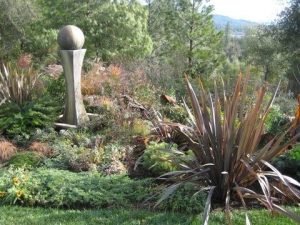A few days ago, it was 70 degrees and spring-like. I was feeling overwhelmed, with a long list of tasks to complete before growing season. Buds and new growth were bursting out all over.
But then-a couple of days later-it was bitter cold and snowing. Nature’s surprise added new challenges, such as checking for fallen limbs, curbing soil erosion, and mulching to protect recently-planted trees and shrubs.
The experience of the last few weeks, plus several years of gardening in the foothills, are reminders that, although a calendar for gardening chores is useful, it is not to be followed absolutely. Weather and growing seasons fluctuate; it’s wise to pay attention to actual conditions.
So, I have a new approach to spring gardening. As soon as weather conditions permit (usually in mid-January), I complete tasks not done in the fall, such as removing dropped fruit, debris and dead branches. This is also the time to prune berry bushes to a size and shape that maximizes fruit production.
Next, I identify and correct any trees with structural problems, dead or diseased limbs or low-hanging branches, starting with the largest trees: oaks, pines, maples, etc. The midsize and patio trees are next. Remove criss-crossing branches and old flowers, thin and give each tree its own space. I also have several shrubs that are being trained to become trees (e.g. redbud, ceanothus, arbutus) so they get extra attention to guide them toward the desired shapes (such as putting weights on branches that should weep).
Young fruit trees are the last in the tree sequence. Prune young fruit trees to open up the center to light and to control growth for easier harvesting and more fruit production. Spray dormant oil and provide sun protection (1/2 white latex paint and ½ water on exposed trunks and limbs) at this time. If prolonged wet weather is expected, cherries and apricots should be pruned in late spring or late summer since they are susceptible to a branch-killing disease, Eutypa dieback, spread by wet weather.
Early March is the time to tackle summer-blooming shrubs, such as roses. Wait to prune spring-blooming shrubs, such as quince, spirea, and ceanothus until after they’ve bloomed. Later, cut back and shape woody perennials, such as salvias, and ornamental grasses.
Finally, it is time (late April or early May) to cut back, groom and shape herbaceous perennials (save the most frost-tender ‘til last). By this time, perennials should show active signs of growth, especially at the crown, and escape the danger of killing freezes.
The last chores of spring clean-up involve final weeding, double-checking irrigation systems and spreading mulch/compost where needed. Define the edges of the garden for a finished, groomed look.
The result of this “triage” approach is that, though the garden does not look beautiful until the very end, clean up is completed when most beneficial. Plants that are most tender are protected until the threat of killing freezes has past.
Marlys Bell is focusing on strategies for sustainable living on her property in Columbia.



